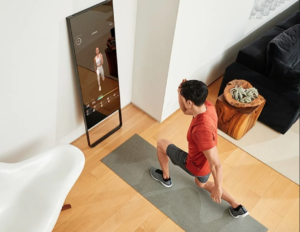The Digital Shift: Working out at home and other “innovations”

Richard Simmons led exercise show in the 1980’s
Working out at home is no new news. In the ‘80s, working moms and housewives worked out with Richard Simmons on PBS and Jane Fonda on VHS. Until the early 2000’s the only other options was big box gyms. And then neighborhood yoga studios started a trend that inspired boutique gyms, like SoulCycle and exhale spa™. From 2007-2018, the “fitness and mind-body sector” experienced meteoric growth. The Global Wellness Institute estimated $828 billion spent in 2018 on fitness/movement experiences.
In 2018 Peloton and The Mirror (and their investors) banked on an audience who wanted to work out from the comfort of home, cutting down on a time-consuming commute and having access at any time of the day with a truly a virtual experience of community or personal trainer. Peloton’s bikes start at $2,245 and treadmills at $4,295, both have an additional $35/month membership. The Mirror sells for $1,495 with an app for group or personalized sessions.

The Mirror, at home workout equipment
During the COVID Pandemic induced shutdown, Peloton’s stock spiked 6% on April 16 to $31.78 per share when the company reported their largest class ever: 23,000 members attending a live class taught by an instructor from her living room. And popped again in early May, to $43.61 on May 18. Current membership is 2 million users. The company is offering 3 months of membership free, where members can access live cycling and treadmill classes, pre-recorded HIIT workouts, yoga classes and more.
Sheltering in place put the pedal to the metal on streaming classes. Teachers and trainers, almost entirely independent contractors who get paid either a flat rate per session or per person in class, needed to keep making money. Freelancers or independent contractors typically do not have sick-leave, vacation pay, personal time off or health care benefits in their employment agreements.
The studios who employ them get paid when people purchase and use classes, either drop-in or class packages. With brick and mortar studios closed, both teachers and studio owners needed a way to keep the cash flowing. It was an all-out hustle.
They figured it out. There were no coordinated efforts or training in place to support them to move as fast as they needed. Some teachers and trainers took on the opportunity to offer classes independent of studios knowing they have an engaged and loyal student base that would be willing, even excited, to take more classes with them.
It was a bit of a “Wild West” situation: Teachers no longer needed to rent out space to teach a class on their own. All they needed was a free- to low-cost Zoom, Facebook or Instagram account to stream video to an unlimited amount of people from anywhere in the world who knew of them or came across their offering through free social media posts or word-of-mouth. They shared their Venmo, PayPal or Zelle account to receive cash (although many started by accepting “donations,” in some cases, instructors later began to price their classes), used Wi-Fi and a device (as simple as a cell phone) to connect to their students, and they were in business, literally. Free enterprise at its best.
Jaqueline (Jaq) Howard shares her experience as a Chicago fitness teacher shifting to teaching digital online classes.
Weeks into COVID-induced closures, email boxes and social feeds are flooded with invitations and offerings of streaming options to keep moving and stay active. Studios were even selling or renting exercise equipment that would have sat idle in closed gyms.
Brand savvy companies like Barry’s Bootcamp sell their branded mats, weights and red light bulbs for a DIY Red Room Studios online to help their tribe feel like they are working out at their beloved gym with their beloved teachers.
Yogaview, one of Chicago’s long established yoga studios has two studio locations, in Lakeview and Wilmette, with five studio spaces total and each with small studios for rent for private sessions (yoga, massage and acupuncture). They are now only offering about a quarter of their total class schedule online through Zoom, losing additional normal revenue from retail and massage services/studio rental.
Research from MindBody estimates that fitness studios around the world are averaging 20% of their normal business through online classes since April 1.
Other wellness niches in the $4.5 trillion Global Wellness Economy, including wellness tourism ($639 billion) are impacted by a halt in travel, and the spa economy ($11.9 billion) is shut down due to social distancing, were not all equally able to shift their offering online.
Next in Series “Is Wellness Sustainable Post COVID?”
Check out Illumine Life YouTube channel for more interviews with wellness professionals in the Chicago-area.
 Lourdes Paredes is the founder of illumine. Lourdes is a leader, a creator and a pioneer in the Chicago wellness community. She has taught yoga since 1999. She is the founder of illumine Chicago, a wellness media platform. She has always looked beyond the yoga mat to help people live their best lives. Lourdes bridges conscious lifestyle & practice. She believes that the most illuminated life is one lived intentionally, and that we all have the power and responsibility to impact the world with our light. Her passion for teaching yoga as an authentic way of life fuels the growth of Illumine.
Lourdes Paredes is the founder of illumine. Lourdes is a leader, a creator and a pioneer in the Chicago wellness community. She has taught yoga since 1999. She is the founder of illumine Chicago, a wellness media platform. She has always looked beyond the yoga mat to help people live their best lives. Lourdes bridges conscious lifestyle & practice. She believes that the most illuminated life is one lived intentionally, and that we all have the power and responsibility to impact the world with our light. Her passion for teaching yoga as an authentic way of life fuels the growth of Illumine.






















No Responses to “Part 2: The Post COVID Digital Shift: Working out at home and other “innovations””